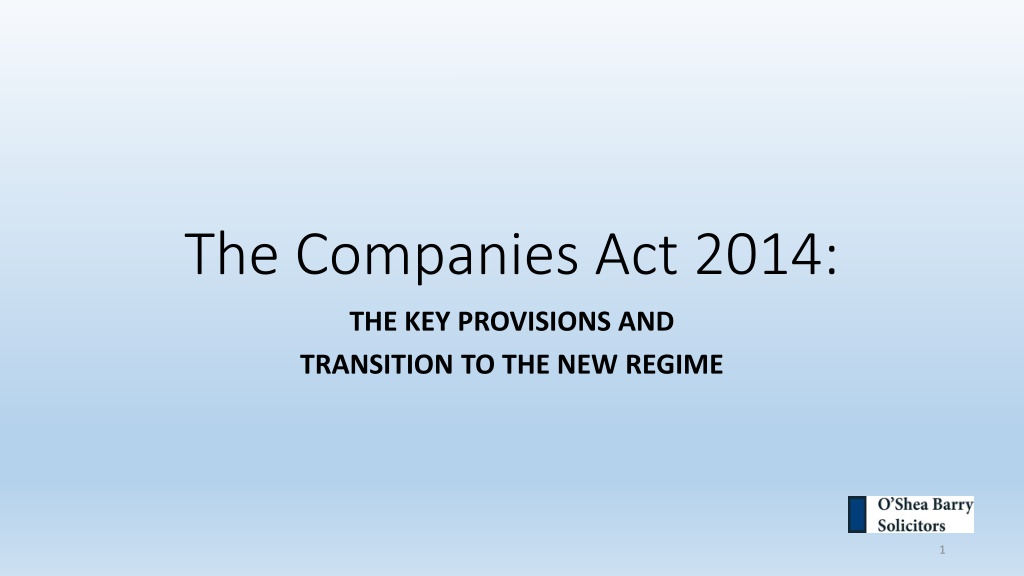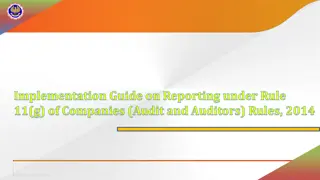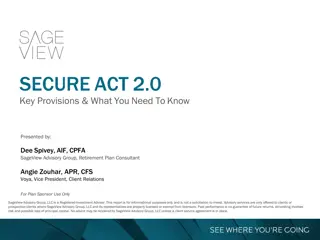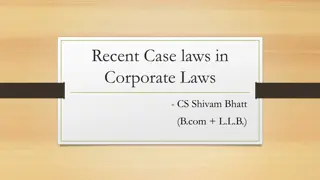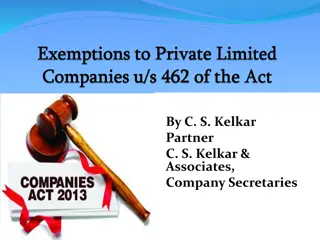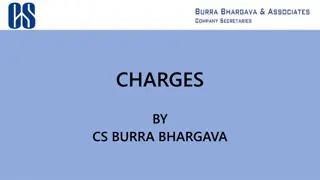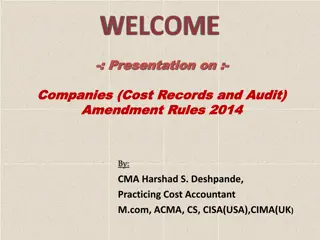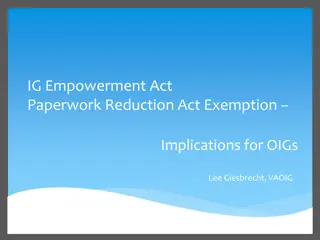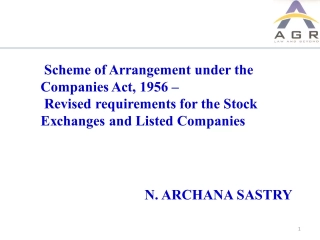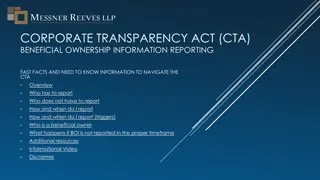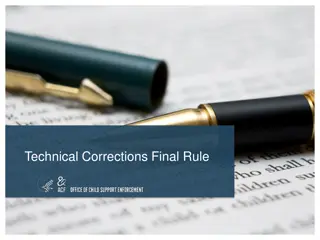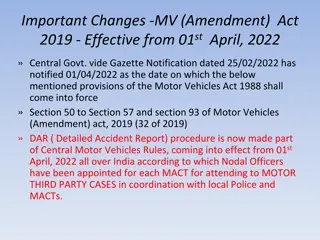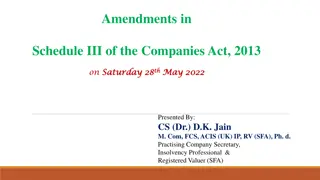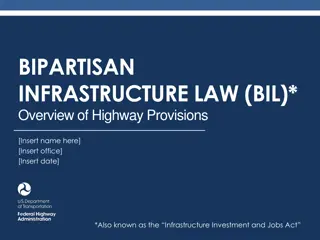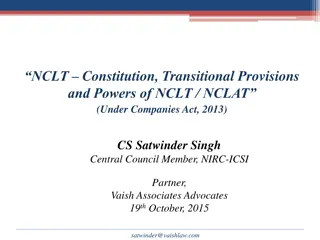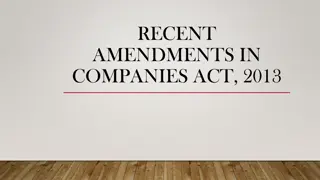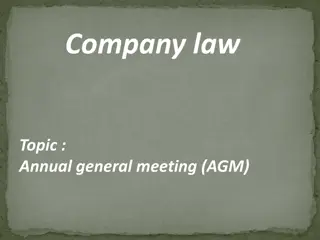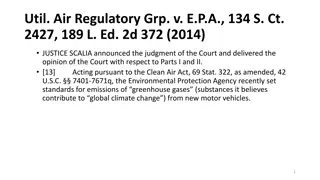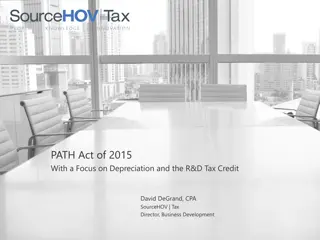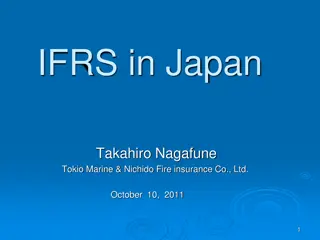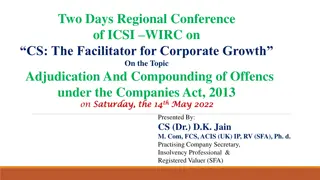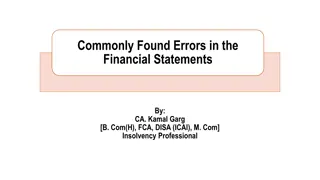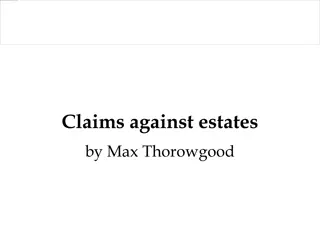Transitioning to The Companies Act 2014: Key Provisions and Changes
The Companies Act 2015, enacted on June 1, 2015, consolidates existing company laws from 1908 to 2013 into a single unified body of legislation. This comprehensive act aims to simplify company law, modernize corporate governance, and reduce administrative burdens. Companies need to decide on suitable structures, directors must adhere to updated duties, and company secretaries must adapt to governance changes. The presentation will cover new private company structures, the decision-making process for converting, differences between LTD and DAC structures, and guidelines for conversion.
Download Presentation

Please find below an Image/Link to download the presentation.
The content on the website is provided AS IS for your information and personal use only. It may not be sold, licensed, or shared on other websites without obtaining consent from the author. Download presentation by click this link. If you encounter any issues during the download, it is possible that the publisher has removed the file from their server.
E N D
Presentation Transcript
The Companies Act 2014: THE KEY PROVISIONS AND TRANSITION TO THE NEW REGIME 1
The Companies Act 2015 came into force on the 1st June 2015. It is largest piece of legislation ever enacted in the state. It is a consolidation of existing Companies Acts from 1908 to 2013 into one unified body of law. The Act primarily is a consolidation but there are some changes which require you to make decisions about your company structure. It is huge body of law that solicitors and accountants are slowly coming to terms with! 3
Parts 1 Parts 1 25 of the Act: 25 of the Act: Part 14 Compliance and Enforcement Part 15 Functions of Registrar and of Regulatory and Advisory Bodies Part 16 Designated Activity Companies ( DAC ) Part 17 Public Limited Companies Part 18 Guarantee Companies Part 19 Unlimited Companies Part 20 Re-registration Part 21 External Companies Part 22 Unregistered Companies and Joint Stock Companies Part 23 Public Offers of Securities, Financial Reporting by Traded Companies, Prevention of Market Abuse, etc. Part 24 Investment Companies Part 25 Miscellaneous Part 1 Preliminary and General Part 2 Incorporation and Registration Part 3 Share Capital, Shares and Certain Other Instruments Part 4 Corporate Governance Part 5 Duties of Directors and Other Officers Part 6 Financial Statements, Annual Return and Audit Part 7 Charges and Debentures Part 8 Receivers Part 9 Reorganisations, Acquisitions, Mergers and Divisions Part 10 Examinerships Part 11 Winding Up Part 12 Strike Off and Restoration Part 13 Investigations 4
Purpose of the Act Purpose of the Act To make your life easier!!! Modernise and simplify company law. Reduce administrative burden on business. Ensure good corporate governance. 5
What What does the Act mean for me? does the Act mean for me? For companies, it means making a decision on which company structure to convert to and in doing so to examine their constitutive documents. For directors, it means absorbing a more focused regime of director duties. For company secretaries, it means becoming familiar with changes in the governance of companies. 6
Overview of Presentation Overview of Presentation Today s presentation will focus on; (i) Two new private company structures Private Company Limited by Shares (LTD) and Designated Activity Company (DAC) (ii) Decision on converting to a new company structure. (iii) The essential differences between a DAC and a LTD. (iv) How to convert? (v) The simplified features of the LTD company including a look at one director companies and the new company constitution. (vi) Directors Duties. The Act also contains significant changes to other aspects of company law including financial reporting and procedures for winding up a company but these will not be examined today. 7
Two New Company Structures All existing private companies are required to convert to either a Private Company Limited by Shares (LTD) or a Designated Activity Company (DAC). The DAC is similar to the current private company while the new LTD company offers a simpler corporate structure. There is an 18 month transition (1st June 2015 30th November 2016) period during which time private companies should convert to either a DAC or LTD. 8
What are the features of the new LTD What are the features of the new LTD company? company? A LTD will not have an objects clause - no legal limit on the company's capacity to engage in different activities. The concept of ultravires (acting outside the company s capacity) therefore does not exist for LTDs as the capacity of the company is not limited (Section 38). The current Memorandum and Articles format replaced by a single document constitution. A LTD will not need to hold a physical Annual General Meetings of shareholders (AGMs), but can instead adopt written resolution without meeting (Section 175). A LTD no longer needs a minimum of two directors. One director will suffice but only where there is a separate company secretary. A LTD s name will not change after conversion and it can continue to use the name Limited or Ltd (or the Irish equivalent). 9
What are the features of the new DAC What are the features of the new DAC company? company? The DAC is similar in many ways to the private company formed under the old Companies Acts. A DAC will continue to require an objects clause in its constitution and its legal capacity will be limited by the scope of that objects clause. If you wish to limit the capacity of your company then you may consider converting to a DAC. A DAC will continue to require two directors and a company secretary. Unless it is a single member company, a DAC will not be entitled to discontinue holding physical AGM. A DAC must change its name to include "Designated Activity Company" or "DAC" (or the Irish equivalent). 10
LTD DAC Company Name Limited/Ltd or Irish translation Designated Activity Company/DAC or Irish Translation Officers At least one director and a company secretary (who cannot be the same person) At least two directors and a company secretary (who can be one of the directors) Structure Private company limited by shares Private company either (a) limited by shares or (b) limited by guarantee having a share capital Share Capital Must have an issued share capital but not an authorised share capital Must have both an issued and authorised share capital Constitution Single document constitution with no objects clause (replacing its current memorandum and articles of association) Memorandum and Articles of Association Corporate Capacity No objects clause. Same capacity as a natural person. Must have an objects clause AGM May dispense with requirement to hold an AGM May only dispense with requirement to hold an AGM if it s a single member company List of Securities May not list or trade securities May list securities (debt securities only subject to certain restrictions) Credit undertakings institutions/insurance Cannot be a credit institution or an insurance undertaking May be a credit institution or an insurance undertaking 11
To DAC or not to DAC? To DAC or not to DAC? This is a decision for each individual company. Certain entities are however obliged to convert to a DAC such as credit institutions and insurance undertakings (Section 18(2). The Central Bank has indicated that it will not require other financial service provides to convert to DACs as it is of the view that corporate structuring is a matter for each entity. To maintain a limit on the scope of your company s activities (as per your current objects clause) you will have to convert to a DAC. It is expected that the majority of current private companies will convert to the new LTD company so as to avail of more simplified corporate governance. 12
What if I ignore everything & do nothing?? What if I ignore everything & do nothing?? If you take no action nobody will be knocking on your door and your company will continue to exist. Today, your company is a DAC! All companies that take no action are treated as DACs until the end of the transition period. At the end of the transition period your company will automatically convert to a LTD. BUT: take no action and default provisions contained in the Act may apply to your company where you may not want them to. If you take action, you control what is in your constitution and can make sure it corresponds with your existing M&A. 13
How to Convert to a LTD? How to Convert to a LTD? Adopt a new constitution (replacing the previous M&A) by special resolution of the members (Section 59). Where members do nothing Directors are obliged to act and pass the resolution to adopt the new constitution, deliver constitution to members and make the filings with the CRO. To effect registration as a LTD you must file with the CRO; Form N1 (Conversion to LTD form) Form G1 Special Registration Form Copy of the company s new constitution 14
How to Convert to a DAC? How to Convert to a DAC? NB: Option to convert to DAC only available up to the 30th November 2016. Up to the 31st August 2016 - pass an ordinary resolution (50% shareholder approval). From 1st September 2016 to 30th November 2016 - pass a special resolution (75% shareholder approval). To effect registration as a new DAC you must file with the CRO the following; Form N2 (Conversion to DAC form) Form G2 Special/Ordinary Registration Form Copy of the company s new constitution (with change of name only) 15
Other simplified features of the LTD Other simplified features of the LTD 1. Majority Written Resolutions (Section 194) Introduction of majority written members resolution with the requisite majority, being 50% for an ordinary resolution and 75% for special resolution. Generally, the effective date for resolutions to take effect are; 7 days for ordinary resolution 21 days for special resolution Unanimous written resolutions take immediate effect. Note: requisite majority for written resolutions is a percentage of the total voting rights of all members who have a right to vote at a general meeting of the company. While the requisite majority for resolutions at meetings is a percentage of the votes cast at the meeting. 16
Other simplified features of the LTD Other simplified features of the LTD 2. One Director LTD Companies (Section 128) A LTD no longer needs a minimum of two directors. One director will suffice. BUT: Single director companies will however require a separate company secretary. This can either be a individual or a company. Professional company secretaries acceptable. Duty on directors to ensure that the company secretary has the necessary skills and resources for the position. This provision is most welcome where often to fulfil the requirement for two directors, a family member would be appointed with little or no involvement in the business. 17
Other simplified features of the LTD Other simplified features of the LTD One Director LTD Companies (Section 128) continued Procedure to become a single director company: Must first convert to a the new LTD company and receive confirmation from the CRO in the form of a new Certificate of Incorporation. Ensure a suitable company secretary is appointed. Other director(s) may then resign or the Company can seek to remove the director(s) by ordinary resolution. (Section 146 procedure for removing directors). Notify the CRO of the resignation/removal of the director Form B10 (or B69 if the Director themselves are notifying the CRO) Notify the Central Bank that company has converted to the new LTD structure and is operating as a single director company. 18
The New Company Constitution The New Company Constitution LTD companies will now have a one document constitution which replaces the current two documents Memorandum of Association & Article of Association New constitution will contain the name of the company, the fact the company is limited by shares, share capital information and any additional regulations the company may wish to specify (Section 19). In theory, it is no longer necessary to have extensive articles set out in the constitution. The new constitution should take the form set out in Schedule 1 of the Act. 19
The New Company Constitution The New Company Constitution The Act abolishes the previous model regulations set out in the Table A and incorporates the majority of these into the body of the Act. Table A provisions are for the most part included in the Act as default provisions but some are now mandatory and others have been omitted completely from the Act. The default provisions will apply to your company unless disapplied or modified in your company s constitution. 21
The New Company Constitution The New Company Constitution Ensure that the bespoke provisions in your company s current M&A are provided for in your new constitution. You may lose some of your bespoke provisions in your previous M&A if you do not include these in your new constitution. You can run with the statuary defaults but if you want to opt-out or modify you must provide for this in your company s new constitution. Examples of some of the statutory defaults provisions that it may be appropriate for you to vary are: 1. Pre-emption rights (Section 69(6)) 2. Written resolutions by directors (Section 161(1)) 3. Notice to directors temporarily absent from the state (Section 160(4)) 4. Powers of alternate directors (Section 165) 5. Power of the director to act in a professional capacity (Section 230) 22
The New Company Constitution The New Company Constitution You may need to opt-in to certain provisions and provide for them in your constitution; Some examples are: 1. The power of the company to allot shares (Section 69(1)). 2. The power of the company to acquire its own shares (Section 105(4)). 3. The power of the company to have an official seal for use abroad (Section 44 (2). 4. Indemnity for officers of the company (Section 235) - The company is only permitted to indemnify a director in defending proceedings in which judgment is given in the director s favour. The provision will need to be included in your constitution as it is not a default under the Act. 23
Directors Duties Directors Duties 1902 judgment Percival v Wright: Directors have but one master, the company . Directors duties have expanded over the years and were principally defined by judicial decision. There was no clear statement of directors duties until this Act. The duties set out in the 2014 Act are primarily a statement of existing duties. The Act ensures greater clarity for existing and prospective directors of their duties. 24
Directors Duties Directors Duties Fiduciary Duties of Directors (Section 228 of the Act): Act in good faith Act honestly and responsibly Act within powers Use of company property Independent judgment Avoid conflicting interests Due care, skill and diligence Regard to shareholders interests 25
Directors Duties Directors Duties General Duties of Directors: Compliance with legislation (Section 223) Interests of employees (Section 224) Compliance statement (Section 223(3) and 225) Appointment of company secretary Section 129(4) Directors duty to disclose any interests in contracts made by the company 26
Directors Duties Directors Duties Breach of Duties Consequences are largely the same as those which applied previously - the company may sue for damages, seek an indemnity for losses or seek an account for profits. Director s Indemnities Include indemnity provision in your new constitution. Director s duties are increasingly the basis for action so obtaining Directors and Officers Liability Insurance may be advisable. 27
Companies Registration Office Companies Registration Office All CRO forms have changed since the 1st June 2015. Old forms are no longer accepted after this date. Most forms have retained the same names (i.e.) B10 is still B10 etc. The new forms now available on CRO website www.cro.ie. 28
Thank you! Thank you! 5 Fitzwilliam Place Dublin 2 Ph: 01 6618199 E: aisling@osheabarry.com 29
